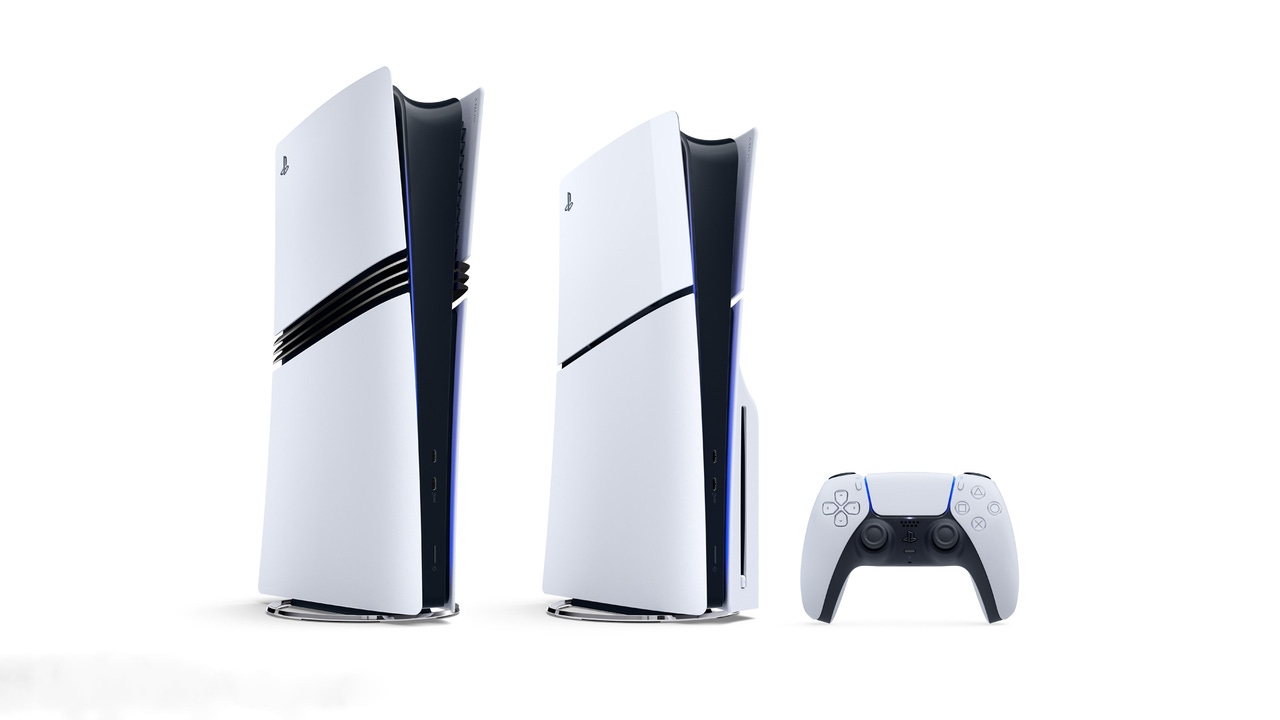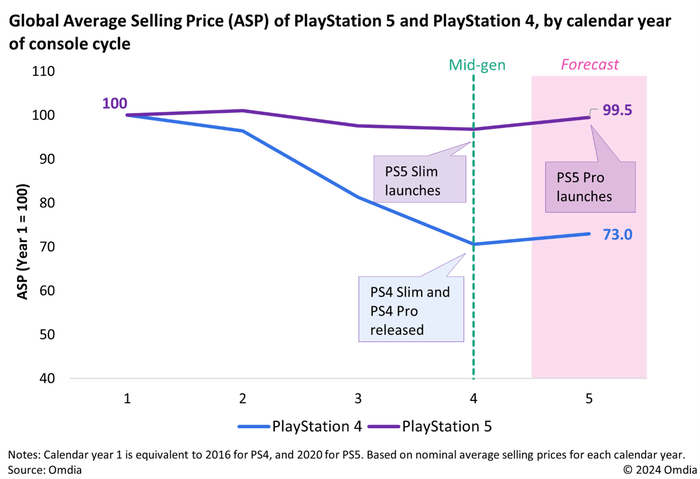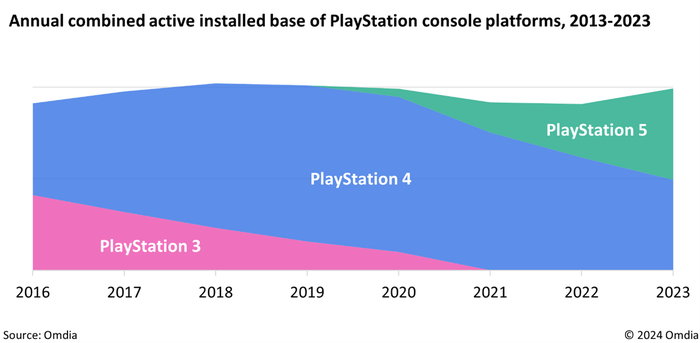Trending
Opinion: How will Project 2025 impact game developers?
The Heritage Foundation's manifesto for the possible next administration could do great harm to many, including large portions of the game development community.

Featured Blog | This community-written post highlights the best of what the game industry has to offer. Read more like it on the Game Developer Blogs or learn how to Submit Your Own Blog Post
PS5 Pro's premium price point is not unexpected, but it is unprecedented.

PlayStation 5 Pro will carry a launch price tag coming in just shy of $700, representing a 75% increase on both the nominal price of its last-gen predecessor PS4 Pro, and a 56% premium on the PS5 Digital Edition. By comparison, PS4 Pro launched at the same launch price as PS4.
While this makes PS5 Pro’s pricing unprecedented for Sony, it is not unexpected. Historically, console manufacturers typically release cost-reduced hardware to address more price-sensitive late adopters – such as 2016’s PS4 Slim ($100 cheaper) and 2019’s Switch Lite (also $100 cheaper).
Yet the cost per transistor has not come down on key components such as the CPU this generation. This has had the knock-on impact of 4Q23’s PS5 Slim hardware revision releasing at either the same or a higher price than 2020’s PS5, depending on SKU and territory.
As a result, hardware ASPs this generation to date have tracked above the previous generation (see Figure 1). On top of this, in 2024 Sony has de-emphasized utilizing regular discounting as a means of growing the PS5 installed base in a bid to preserve the profitability of its hardware.
Figure 1: ASP of PS5 hardware has remained notably higher, gen-on-gen, than PS4

Source: Omdia Games Hardware Database
PS5 Pro’s $700 price point makes it an aspirational device aimed at players who desire the very best experience. Platform holders have historically catered to this small but highly engaged audience in the past with niche systems that lay adjacent to popular home console platforms, such as 1991’s Neo Geo AES ($649 or $1502 in real terms) and 1993’s 3DO ($699, or $1512 in real terms).
The difference today is that the premium “Pro” consoles are mid-gen refreshes – they are additive to what are existing, thriving console platforms. In the case of PS5 Pro, it will still sit alongside an active installed base of PS4, PS4 Pro, and PS5 players – of which their software and services boast significant interoperability.
Figure 2: Pro consoles accounted for just 13% of combined PS4 and Xbox One installed base by end of 2019

Source: Omdia Games Hardware Database
It’s also not the first of its breed – Sony has already had a run of history with PS4 Pro. Omdia data reveals that just 1.8 million PS4 Pro systems were sold in its launch year, 2016. By the end of its fourth calendar year on the market, 2019, the 13.9m units of PS4 Pro sold accounted for under 15% of the overall PS4 installed base.
Similarly, Omdia’s historical console hardware data reveals that the equivalent Microsoft system, Xbox One X, also only accounted for just over 10% of installed consoles following the same timeframe. Combined, both “Pro” machines only accounted for just over 13% of the installed base of PlayStation 4 and Xbox One consoles (see Figure 2).
Despite PS4 Pro’s comparatively competitive pricing, then, it was always an enthusiast device – a stark contrast to previous mid-generation upgrades such as Game Boy Color, DSi, and New Nintendo 3DS. And Sony has usage data on PS4 and PS5 players that will have pinpointed a large enough highly engaged portion of its audience that would make PS5 Pro a worthwhile endeavor to pursue.
Figure 3: Total addressable market across PlayStation consoles largely static gen-on-gen

Source: Omdia Games Addressable Market Metrics Database
It’s this engagement that is key to understanding Sony’s strategy with PS5 Pro. With the active installed base of PlayStation users remaining static as it transitions between generations (see Figure 3), Sony has focused its attention on increasing lifetime spend per console. This has materialized in the following ways:
PS5 Pro is another means for Sony to either target the highly engaged – or allow the highly engaged to self-select themselves into the PlayStation ecosystem.
And yet despite the above, Omdia does not anticipate PS5 Pro to sell in the same volumes as its predecessor. PS4 Pro not only launched at a comparatively lower price point, but coincided with both the adoption of 4K TVs hitting a critical mass. It also launched simultaneously alongside PlayStation VR, a more compelling platform than current-generation successor PS VR 2.
As PS5 approaches its fifth full year on the market without a single permanent price drop, the absence of key first-party blockbuster games throughout 2024 coupled with a prolonged cross-generation period has led to PS5 entering its decline phase a year earlier than PS4 did in its cycle.
Omdia’s preliminary console forecast estimates that even in a best-case scenario, sales volumes for PlayStation 5 would still decline by 17% in 2024, when compared with 2023.
Right now, PlayStation 5 Pro is set to launch alongside the casual-friendly Lego Horizon Adventures, which is currently the only confirmed major first-party title slated for the holiday season. By comparison, PS4 Pro launched in close proximity to fan favorite first-party triple-A games such as Uncharted 4, The Last Guardian, and Gravity Rush 2.
PS5 Pro is also arriving in a development landscape where the gestation period for triple-A games is longer and more costly than it was in the previous generation. This has materialized as a sustained cross-generation period in the PS5’s cycle, where publishers have only recently begun leaving behind the last-generation systems for their triple-A games. Yet at the same time, 2024 has also been a quiet year for such major releases.
Sony does, however, have an opportunity to ride off the halo effects created by Grand Theft Auto 6, which is expected for release in 2025. The game is expected to launch exclusively on console platforms, with a PC release coming at least a year later. This would leave PlayStation 5 Pro as the premier place to experience what is one of the most hotly anticipated games in the modern age. If Sony is smart, it should strike a marketing deal with publisher Take-Two to promote the game alongside its new console.
PS5 Pro will prove an interesting case study for the console market due to its notable contrast against its predecessor PS4 Pro. That older system was a defense strategy against the moving baseline of PC gaming hardware and an answer to the adoption of 4K TVs.
Meanwhile, PS5 Pro is razor-focused on an audience which wouldn’t think twice about moving to PC. But at its $700 price point, the stakes will be high for PS5 Pro to deliver a tangible benefit to this audience in the three-four years before Sony begins its transition to PS6, especially in a generation that has delivered fewer exclusive blockbuster games than the last.
You May Also Like